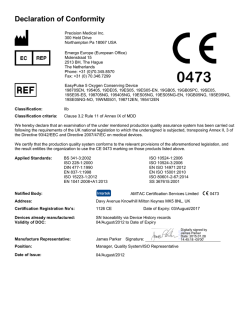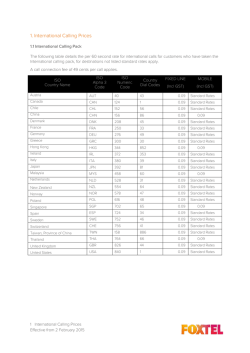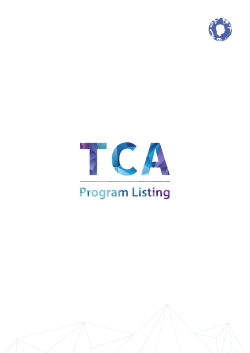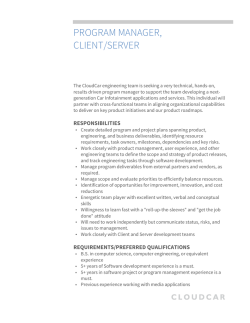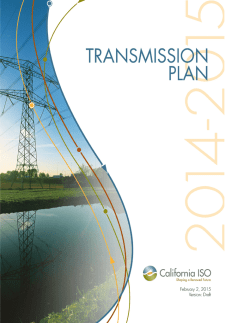
2011-2015 ISO Strategic Plan
ISO Strategic Plan 2011-2015 Solutions to Global Challenges ISO the International Organization for Standardization ISO has a membership of 163* ISO only develops standards national standards bodies from for which there is a clear mar countries large and small, in ket requirement. The work is dustrialized, developing and in carried out by experts in the transition, in all regions of the subject drawn directly from the world. ISO’s portfolio of over industrial, technical and busi 18 500* standards provides ness sectors that have identi business, government and so fied the need for the standard, ciety with practical tools for all and which subsequently put the three dimensions of sustainable standard to use. These experts development: economic, envi may be joined by others with ronmental and social. relevant knowledge, such as representatives of government ISO standards make a positive agencies, testing laboratories, contribution to the world we live consumer associations and in. They facilitate trade, spread academia, and by international knowledge, disseminate inno governmental and nongovern vative advances in technology, mental organizations. and share good management and conformity assessment An ISO International Standard practices. represents a global consensus on the state of the art in the ISO standards provide solutions subject of that standard. and achieve benefits for almost all sectors of activity, includ ing agriculture, construction, mechan ical engineering, manu facturing, distribution, transport, medical devices, information and communication technol ogies, the environment, energy, quality management, conformity assessment and services. ISO Strategic Plan 2011-2015 * At the end of October 2010. 2011-2015 Global Vision for ISO in 2015 ISO ’s Mission To be the world’s leading ISO develops high quality provider of high quality, globally voluntary International Standards relevant International Standards which facilitate international through its members and exchange of goods and services, stakeholders S even Key Objec tives to Achieve the Vision support sustainable and equitable economic growth, promote innovation and protect health, safety and the environment. ISO develops its standards through an effective process which meets customer needs and : ● Ensures consensus amongst stakeholders and across countries, through the national delegation principle ● Is fully compliant with the core principles affirmed in the ISO Code of Ethics, that require the process to be open, transparent and impartial ● Increasingly facilitates and supports the participation of developing countries ● Produces coherent, effective, widely recognized and relevant standards. ISO Strategic Plan 2011-2015 1 ISO deliverables meet customer needs In each sector that ISO the implementation of ISO government, consumers and standards to maximise benefit other stakeholders recognize to standards users and learn and rely on ISO as the leading from market experience to platform for the development further improve the global and dissemination of globally relevant solutions. Ac tions 1.1 Ensure that ISO deliverables are solutions-oriented and create substantial value for standards users, meeting customer needs in terms of type of deliverable, quality of content, clarity, format and access 1.2 Ensure that ISO is the preferred international forum in which to meet standardization needs in existing and new areas that address globally relevant issues and for which solid justification, clear objectives and broad stakeholder support exist 1.3 Design and develop more advanced electronic deliverables making the content of standards accessible to users in relevant formats and media ISO Strategic Plan 2011-2015 1.4 Promote and encourage addresses, business, relevance and uptake of ISO standards 1.5 Develop a coherent, modular system of management systems standards that support lean and cost-effective implementation, based on the views of users 1.6 Ensure that ISO standards and guides relating to conformity assessment practices are comprehensive, harmonized and suitable for all types of enterprises from all nations. A claim of conformity must result in a high level of user confidence. 2 ISO standards promote innovation and provide solutions to address global challenges ISO standards incorporate 2.4 Promote International state-of-the-art knowledge of Standards as enablers for relevance to standards users bringing innovation to the and are broadly used to address market place, facilitating the the global challenges of the development of new markets 21 st century and the improvement of consumer understanding and Ac tions confidence. 2.1 Reinforce ISO’s ability to address global challenges by identifying, prioritizing and developing International Standards that anticipate and meet market and society needs 2.2 Provide and promote International Standards as instruments that support technological change, process improvement and technology transfer among sectors and across borders 2.3 Actively develop links between standards and research and development to foster innovation by utilizing the ISO members’ network ISO Strategic Plan 2011-2015 3 The capacity and par ticipation of developing countries in international standardization is significantly enhanced Participation of developing identification of priority ardization is essential to ensure sectors in economies and the global relevance of ISO national infrastructures, to standards and to contribute to optimize the involvement of developing countries’ access to developing countries in the world markets, technical progress development, adoption and and sustainable development. implementation of International Standards ISO succeeds in enhancing developing country participation 3.4 Include in ISO’s strategic through processes, programmes priorities the standardization and tools which assist them in fields of key interest to building their standardization developing countries capacity, engage national stakeholders, participate effectively in technical work and implement International Standards. Ac tions 3.1 Identify the successful measures that have the potential to expand standardization capacity building, technical assistance and training, facilitation of participation in standards development and dissemination of standards content and incorporate them into the new Action Plan for developing countries for the period 2011-2015 3.2 Implement the Action Plan for developing countries 2011-2015 ISO Strategic Plan 2011-2015 3.3 Share best practices for the countries in international stand- 3.5 Encourage membership in ISO and help national standards bodies to fully exploit the benefits attached to such membership, taking into account the specific needs of members from countries with limited resources (such as those from smaller countries) 3.6 Strengthen ISO’s cooperation with regional economic communities and regional standards organizations, promote and encourage cooperation and exchange of experience between ISO members at the regional and sub-regional level. 4 ISO excels in reaching out to and engaging stakeholders Active involvement in the 4.3 Support the engagement and ISO standards development participation of stakeholders process of industry, govern- with limited resources, such as ment, consumers and other smaller enterprises and stakeholders is essential and consumers ensures the relevance, quality and use of ISO standards. Through the national members, ISO ensures the engagement of all relevant stakeholders, facilitates their participation in standards development and recognizes their contribution Ac tions 4.4 Clarify to public authorities that ISO standards are voluntary, do not seek to establish public policy, and bring substantial value as efficient and cost effective tools in support of the implementation of public policies and as an element of good public governance 4.5 Differentiate International Standards, developed in 4.1 Identify, develop and promote compliance with ISO’s due best practice for effective process, from other types of guidance and monitoring tools standards or specifications that assist ISO members and liaisons in engaging stake- 4.6 Promote participation of holders from each of the government representatives in relevant stakeholder groups the standards development and monitor the representation process through ISO members and balance of stakeholder or intergovernmental engagement organizations. 4.2 Communicate standardization projects more effectively to stakeholders at the international and national levels, using new technologies and tools in order to capture broader stakeholder views during the development process ISO Strategic Plan 2011-2015 5 ISO fosters par tnerships that fur ther increase the value and efficient development of International Standards ISO effectively promotes and provide sound business manages partnerships with knowledge in specific sectors international organizations, or fields; identify the need for standards developing new ISO standards; and organizations, industry consortia, civil society and academia, to increase the value and the efficient development of International Standards Ac tions 5.1 Work more closely with IEC and ITU to align policies and coordinate activities, especially in areas of converging technologies, with a view to efficiently serving the needs of stakeholders and of the ISO constituency 5.2 Strengthen the cooperation with existing and potential new partner standards developing organizations, with industry consortia, the scientific community and civil society, when such partnerships add value to and increase the efficiency of the development of International Standards 5.3 Further extend the close cooperation with intergovernmental organizations and international stakeholder organizations that can ISO Strategic Plan 2011-2015 support their market acceptance 5.4 Strengthen the cooperation with regional standards organizations to foster information exchange within each region on ISO strategic directions and standards projects, and to identify priorities for new ISO standards in each region 5.5 Ensure that liaison organizations provide a benefit to ISO and its committees that is comparable with the benefit they receive through their access and influence in ISO. 6 ISO and its processes are significantly improved ISO uses clear, transparent 6.5 Provide high quality training and rigorous procedures and support services to all and implements optimal participants in standards structures, systems and development and implemen- processes, to support the tation, helping them to development of high quality effectively participate and use deliverables that meet the standards needs of standards users. Ac tions 6.1 Ensure that the structure and 6.6 Ensure that all stages of ISO’s standardization process benefit from best practice IT support systems. governance of ISO are efficient and effective and support ISO’s mission and vision 6.2 Create clear, closer links between high-level priorities and actual TC/SC work programmes 6.3 Improve the efficiency and effectiveness of the standards development process with a view to increasing the quality and speed of development of ISO deliverables 6.4 Ensure that TC/SC secretariats and chairs are assigned to those individuals and organizations that are in a position to be the most effective in achieving the goals of the ISO system ISO Strategic Plan 2011-2015 7 ISO and the value of voluntar y International Standards are clearly understood by customers, stakeholders and the general public ISO communication to all based services, new media and categories of stakeholders, both communication platforms such in support of its members and as social networks through its information services and networking initiatives, has significantly raised the profile of ISO and led to an increased recognition of the importance of its activities. Ac tions 7.1 Intensify market understanding and analysis, through cooperation with ISO members and improve on communication and promotion activities, with a view to extend ISO’s reach and demonstrate value to users 7.2 Promote existing studies and develop new studies to demonstrate the economic and social benefits of International Standards to organizations, industries, the public sector and society 7.3 Develop communication material, publications and services for clearly identified target audiences that can be used by the ISO constituency. Special attention will be given to Web- ISO Strategic Plan 2011-2015 7.4 Strengthen the cooperation with education institutions at national and international levels, to develop and support curricula on standardization at all levels of education, and to include academia’s contribution, from the cutting edge of research and technology, in the standards development process. ISO ’s added value is based on : ● Recognized experience in international consensus building ● Wide recognition of brand and name on the world scene ● Robust, well-proven processes that are transparent, inclusive and open to ensure that ISO standards are the result of strong ● consensus among a wide range of relevant stakeholders A broad range of deliverables covering most sectors of the economy, and core issues affecting the environment and society ● Strong national membership base which ensures broad consensus, wide dissemination of ISO deliverables and market feedback for their maintenance and development ● ● Extensive networking, at both international and regional levels Ability to provide International Standards to assist in the implementation of regulations ● Leadership in the production of standards and guides for conformity assessment ● Leadership in the use of IT tools for the production and dissemination of standards. ISO Strategic Plan 2011-2015 ISO Central Secretariat 1, ch. de la Voie -Creuse Case postale 56 CH-1211 Genève 20 Switzerland Tel.: +41 22 749 0111 Fax : +41 22 733 34 30 E-mail : [email protected] Web : www.iso.org © ISO, 2010-11/5 000 All rights reser ved. ISBN 978-92-67-10542-0
© Copyright 2026
